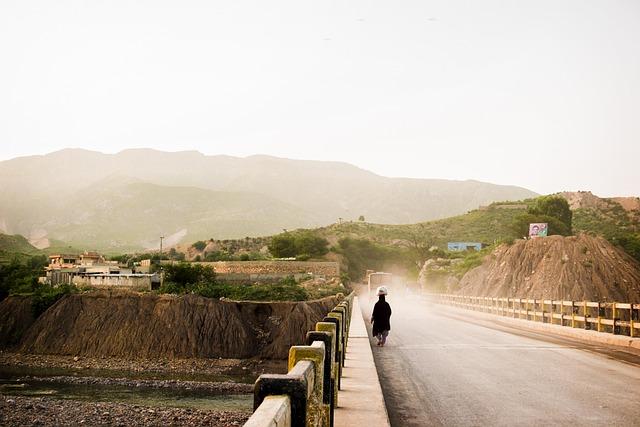In the heart of South Asia, where traditions intertwine with modern aspirations, Pakistan’s media landscape is undergoing a profound transformation. As the nation grapples with the complexities of its identity, the interplay between news, entertainment, and digital connectivity reveals both remarkable triumphs and formidable challenges. From the roar of television anchors during breaking news segments to the quiet yet potent influence of social media platforms, Pakistan’s media serves as both a mirror reflecting society and a catalyst for change. This article delves into the multifaceted evolution of Pakistan’s media, exploring how it navigates the delicate balance between freedom and regulation, innovation and authenticity, while shaping public discourse in an ever-changing world. Join us on this journey through the highs and lows of a dynamic sector that continues to redefine itself amidst the swirling currents of culture, politics, and technology.
Transformative Trends in Digital Media: Navigating the New Frontier
The media landscape in Pakistan is undergoing a radical transformation, spurred by profound technological advancements and shifting consumer behaviors. With the rise of digital platforms, traditional media is facing both challenges and opportunities like never before. The emergence of social media and user-generated content has democratized information dissemination, allowing anyone with an internet connection to become a content creator. This shift has led to:
- A surge in online news portals that cater to diverse viewpoints.
- The proliferation of mobile journalism, enabling rapid reporting from anywhere.
- An increase in audience engagement, as consumers can directly interact with media personalities.
However, this evolution is not without obstacles. The rise of disinformation and lack of regulatory frameworks poses a significant threat to media credibility. The local media is grappling with issues such as censorship, as well as economic challenges that hinder sustainable growth. To illustrate this, here’s a snapshot of key challenges currently faced by the media industry in Pakistan:
| Challenge | Description |
|---|---|
| Censorship | Restrictions from government entities affecting freedom of press. |
| Quality Control | Combatting fake news and ensuring content reliability. |
| Monetization | Struggling to develop viable revenue models in digital spaces. |

Press Freedom in Focus: Balancing Regulation and Independence
The media landscape in Pakistan is increasingly characterized by a tension between the need for regulation and the imperative of maintaining journalistic independence. State interventions and media laws have historically aimed to control narratives and curb dissent, often exacerbated by the dynamic political environment. However, the rise of digital platforms has empowered a new generation of journalists and citizens, who utilize social media to disseminate information and challenge the status quo, pushing the boundaries of traditional journalism. This duality necessitates a nuanced approach to media governance, whereby the government and regulatory bodies must collaborate with media stakeholders to create frameworks that uphold transparency and accountability while protecting the freedom of the press.
Amidst this complex backdrop, various media organizations in Pakistan have begun to champion press freedom, pioneering initiatives that promote ethical journalism and investigative reporting. Notable efforts include:
- Training programs for journalists to navigate threats and enhance reporting skills.
- Advocacy campaigns aimed at raising public awareness about media rights.
- Partnerships with international organizations to bolster resources and expertise.
Despite the myriad challenges, including censorship and harassment, these triumphs signify a growing resilience within the industry. The evolution of media organizations towards greater independence represents a commitment to fostering a vibrant democratic discourse, which remains pivotal to Pakistan’s future.

The Role of Education in Media Literacy: Equipping the Next Generation
In an age where information flows ceaselessly through various channels, the importance of education in media literacy cannot be understated. As young minds are bombarded with content from social media platforms, news outlets, and digital influencers, equipping them with the skills to critically assess the information they encounter is vital. Educational institutions in Pakistan are beginning to take strides in this direction by integrating media literacy programs into their curriculums. Such programs aim to foster a generation that not only consumes media but engages with it thoughtfully and discerningly. Key components of these initiatives include:
- Critical Thinking Development: Encouraging students to question the source and intent behind messages.
- Fact-Checking Skills: Teaching methods for verifying information and identifying misinformation.
- Amplifying Diverse Voices: Highlighting various perspectives to create a more inclusive understanding of media narratives.
Moreover, collaboration between educators, policymakers, and media organizations can further bolster these efforts. By creating a comprehensive framework that addresses the unique challenges faced by the Pakistani media landscape, stakeholders can better prepare students for the intricacies of modern media consumption. This approach not only empowers youth with essential skills but also fosters a more informed citizenry. The potential impact can be represented as follows:
| Focus Area | Potential Benefits |
|---|---|
| Innovative Curriculum | Enhanced engagement and retention among students. |
| Community Workshops | Improved media literacy across diverse demographic groups. |
| Partnerships with Media Outlets | Real-world insights and access to credible resources. |

Future Pathways: Strategies for Sustainable Growth in Journalism
As the media environment in Pakistan continues to evolve, there is a pressing need for innovative strategies that prioritize both sustainability and growth. Embracing digital transformation is essential, as it allows journalists to reach broader audiences and adapt to the changing consumption patterns of news. Key strategies include:
- Diversifying Revenue Streams: Media organizations should explore various funding models such as subscription services, crowdfunding, and partnerships with NGOs to minimize reliance on traditional advertising.
- Enhancing Digital Literacy: Equipping both journalists and the public with skills to navigate the digital landscape can foster a more informed society, increasing trust in media.
- Fostering Community Engagement: Building strong connections with local communities can lead to richer, more relevant content, while also creating loyal viewers and readers.
Furthermore, fostering collaboration among media outlets can pave the way for shared resources and knowledge, propelling the industry towards a more resilient future. Establishing media incubators and mentorship programs could support aspiring journalists, nurturing talent that reflects the diverse narratives within Pakistan. A possible structure for collaboration can include:
| Collaborative Model | Description |
|---|---|
| Shared Content Platforms | Joint platforms where different media houses publish collaborative articles and reports. |
| Resource Pooling Initiatives | Combining financial and human resources for large investigative projects. |
| Training Workshops | Regular sessions where experienced journalists train newcomers in best practices and ethics. |
Future Outlook
As we conclude our exploration of Pakistan’s evolving media landscape, it is clear that this dynamic field embodies a tapestry woven from threads of resilience and innovation. The challenges faced — from censorship to the digital divide — pose significant hurdles; yet, they also serve as catalysts for creativity and reform. In this intricate dance between tradition and modernity, Pakistani media continues to carve out spaces for diverse voices, shaping public discourse and serving as a mirror to the society it reflects.
As we look ahead, the triumphs seen in independent journalism, digital activism, and flourishing new platforms offer a glimpse of a brighter, more inclusive media future. The journey is ongoing, and while uncertainties loom, the spirit of the media in Pakistan remains unbroken, charged with potential and a collective commitment to truth. In navigating the complexities of this landscape, one thing is certain: the evolution of media in Pakistan is a story still being told, with every new chapter promising to redefine not only the narrative but the very essence of communication in this vibrant country.



